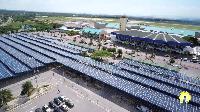
A leading issue related with the utilization of renewables is how can large scale energy production is possible with the potential of nearly 850 GW potential in solar energy alone. If renewables were able support the country’s effort to meet the rising demand, large scale production and gridding of such energy generated is necessary.
On this goal, the Ministry of New and renewable Energy (MNRE) along with its affiliate Solar Energy Corporation (SECI) have launched Solar Park scheme to encourage the construction of solar parks that can generate electricity above between 500 MW and 1000 MW. The Solar Parks/ Ultra Mega Solar Power Projects will be set up across various states for five years that is from 2014-15 to 2019-20.
Objective of the government as per the revised policy is to create at least 50 solar parts with a capacity of 500 MW and above by 2019-20. The government will make a budgetary allocation of Rs 8100 crores for the project for providing financial assistance to the parks.
MNRE’s aim is thus to set up at least 50 solar parks, each with a capacity of 500 to 1000 MW; thereby targeting around 40000 MW (revised from the original 20000 MW) of solar power installed capacity. Ultra-Mega Solar Power project is a single power project with capacity of over 500 MW.
What is a solar park?
The solar park is a concentrated zone of development of solar power generation projects and provides developers an area that is well constructed, with proper infrastructure, access to amenities and by minimizing paper works for project implementation.
Power Purchase Agreement should be signed by the solar park developer (may be a private sector entity) with state and central government utilities who purchases power. Price will be set in accordance with the regulations of Central Electricity Regulation Authority.
The Scheme proposes to provide financial support by Government of India to create the necessary infrastructure at new solar power projects. Incentives in the form of allocation of land, transmission and evacuation lines, access roads, availability of water and others, can be made under the project.
Smaller parks of 100 MW and above may be considered in NE, HP, Uttarakhand and J&K. Smaller parks of 100 MW and above may also be considered in UT’s and small States with population less than 2 crores. Higher than 1000 MW capacity parks may also be considered under special circumstances.
Charanka Solar Park in Gujarat is an example, envisioned as a pioneering first-of-its-kind large scale solar park in India with clear land and transmission connectivity. Solar park project also witnessed the welcome trend of declining power costs. A Finland firm has quoted Rs 4.34/unit for the NTPC’s Bhadla Solar Park tender in early 2016.
Gridding the generated electricity to the ultimate locations will be made through green corridors.
*********









